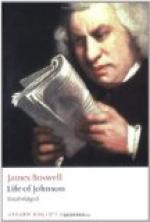there runs a rivulet with a good quantity of water,
forming several cascades, which make a considerable
appearance and sound. The first thing we came
to was an earthen mound, or dyke, extending from the
one precipice to the other. A little farther on
was a strong stone-wall, not high, but very thick,
extending in the same manner. On the outside
of it were the ruins of two houses, one on each side
of the entry or gate to it. The wall is built
all along of uncemented stones, but of so large a
size as to make a very firm and durable rampart.
It has been built all about the consecrated ground,
except where the precipice is steep enough to form
an inclosure of itself. The sacred spot contains
more than two acres. There are within it the ruins
of many houses, none of them large,—a
cairn,—and
many graves marked by clusters of stones. Mr.
M’Queen insisted that the ruin of a small building,
standing east and west, was actually the temple of
the Goddess ANAITIS, where her statue was kept, and
from whence processions were made to wash it in one
of the brooks. There is, it must be owned, a hollow
road, visible for a good way from the entrance; but
Mr. M’Queen, with the keen eye of an antiquary,
traced it much farther than I could perceive it.
There is not above a foot and a half in height of
the walls now remaining; and the whole extent of the
building was never, I imagine, greater than an ordinary
Highland house. Mr. M’Queen has collected
a great deal of learning on the subject of the temple
of ANAITIS; and I had endeavoured, in my
Journal,
to state such particulars as might give some idea of
it, and of the surrounding scenery; but from the great
difficulty of describing visible objects[609], I found
my account so unsatisfactory, that my readers would
probably have exclaimed
‘And write about
it, Goddess, and about it[610];’
and therefore I have omitted it.
When we got home, and were again at table with Dr.
Johnson, we first talked of portraits. He agreed
in thinking them valuable in families. I wished
to know which he preferred, fine portraits, or those
of which the merit was resemblance. JOHNSON.
’Sir, their chief excellence is being like.’
BOSWELL. ’Are you of that opinion as to
the portraits of ancestors, whom one has never seen?’
JOHNSON. ’It then becomes of more consequence
that they should be like; and I would have them in
the dress of the times, which makes a piece of history.
One should like to see how Rorie More looked.
Truth, Sir, is of the greatest value in these things[611].’
Mr. M’Queen observed, that if you think it of
no consequence whether portraits are like, if they
are but well painted, you may be indifferent whether
a piece of history is true or not, if well told.
Dr. Johnson said at breakfast to-day, ’that
it was but of late that historians bestowed pains
and attention in consulting records, to attain to
accuracy[1]. Bacon, in writing his history of
Henry VII, does not seem to have consulted any, but
to have just taken what he found in other histories,
and blended it with what he learnt by tradition.’
He agreed with me that there should be a chronicle
kept in every considerable family, to preserve the
characters and transactions of successive generations.




